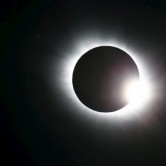
People are expected to flock outdoors on March 20 to see the biggest solar eclipse in the UK since 1999. Many people will head out to open spaces and coastal areas to make the most of nature’s show but those people heading to beaches and the shore are being urged to think about safety as well as the spectacle in the sky.
The day of the solar eclipse is likely to see a high spring tide and the event itself will last more than an hour, meaning that it is possible that people will become so caught up in the show that they fail to notice the movement of the sea. That is why people are being urged to remember to check tide times and conditions before heading to beaches and coastal areas and stay aware in areas where there is a danger of them being cut off or put in another kind of danger.
The solar eclipse will last for two minutes and 46 seconds at its longest (viewed from the Faroe Islands where a total eclipse will be seen) but the whole experience will last much longer than this, even in the UK, which will experience a partial event. The time of the eclipse in the UK will vary from north down to the south of England. It will start in Edinburgh at 08.30UT. At 09.35, the sun will be a total of 93 per cent covered. London will experience an 84 per cent eclipse, which will start at 8.24UT and be at its fullest at 9.30UT.
The next total eclipse in Europe will not be seen for more than a decade, on August 12, 2026, and the next one to be visible from mainland Britain will not be until September 23, 2090.
